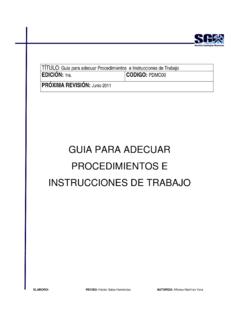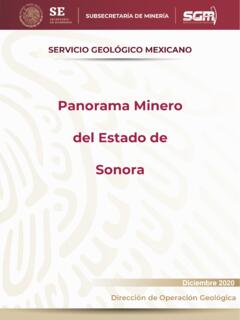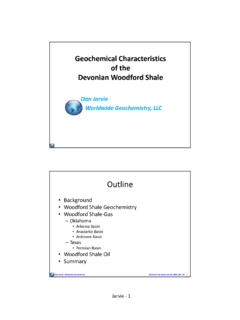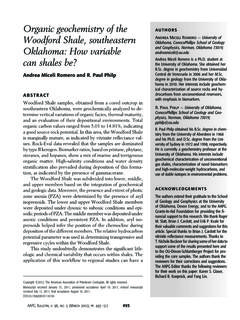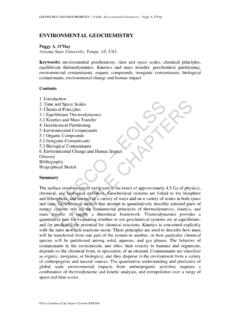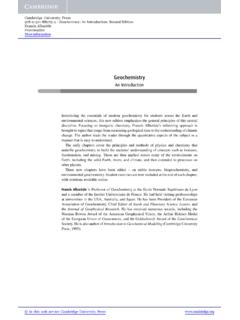Transcription of What is Geochemistry? - sgm.gob.mx
1 what is geochemistry ? geochemistry studies the origin, evolution and distribution of chemical elements on Earth which are contained in the rock-forming minerals and the products derived from it, as well as in living beings, water and atmosphere. One of the goals of geochemistry is to determine the abundance of elements in nature, as this information is essential to hypotheses development about the origin and structure of our planet and the universe. Elements and Earth An element is material which has a particular kind of atom with specific electronic structure and nuclear charge, factors that determine their abundance in the rocks. Regarding distribution, it can only have direct evidence on the composition of the Earth's crust and indirect on the mantle and core. Current knowledge of the geochemical nature of the crust comes from the analysis of geophysical data and rock.
2 According to these analyzes, oxygen is the main element of the cortex with 47% by weight and 94% by volume; second place is silicon, with 28% by weight, but less than 1% by volume. Moreover, metals are a mineral deposit of economic importance when its average of content is concentrate. For example, iron and aluminum, which are the most abundant, must concentrate from 4 to 5 times, copper 80, platinum 600, silver 1250, gold nearly 4000 and tungsten and mercury, which are the rarest, should be concentrated more than 10,000 times to be mineable with economic performance. Extraction Until about two decades ago, the exploration was restricted to easily detectable outcropping mineralized bodies, however, today exploration has led to deposits that are not exposed to the surface and therefore are difficult to locate. For this new type of indirect exploration, it has been developed different methods for the detection of hidden mineralized bodies; one of them is the geochemical prospection which is based on established principles of geochemistry cycle and distribution of elements.
3 geochemistry exploration applied to mining has three main purposes: 1. Search for metals in different adjacent parts to a known deposit, defining its extinction, reiterate and new mineral bodies. 2. Finding deposits in wilderness areas. 3. Definition and delimitation of mineralized belts and/or metallogenic provinces. Geochemical environments Among the fundamental principles of geochemistry is the recognition of geochemical environments that are developed in the earth's crust and are grouped into: Surface geochemical environment: also referred to as supergene, secondary and exogenous. This environment has clearly superficial conditions and features, such as low temperature and pressure, free fluids movement, plenty oxygen, water and carbon dioxide. In these environment actions such as weathering, erosion, sedimentation and soil is where formation occurs.
4 Dispersion: is the formation of a mineral deposit with a certain distribution of the ore minerals or elements associated with them. A halo around the deposit is formed from a few centimeters to kilometers of extension. The dispersion may be of the following types: - Primary dispersion: involves all emplacement processes during the formation of how the mineralized body was formed. - Secondary dispersion: involves the redistribution of primary models, by any subsequent process; often develop under conditions of low temperature and pressure. Both types depend on the geochemical mobility of elements, and this one as well, is subject to the mechanical properties (mobile stage of mineral), viscosity, solution, size, shape and density of the grains and the physic-chemical features of each element. As a result, geochemical exploration focuses on the determination of the elements of the ore or elements associated with the ore that are dispersed, called respectively indicator elements and guide elements.
5 For example, in a deposit of lead-zinc sulfide, the indicator elements are lead and zinc, while a guide element will be mercury. The different kinds of studies that can be performed by developing the sampling elements are: Stream sediment geochemistry . Soil geochemistry . Rock geochemistry . Gas geochemistry . Water geochemistry . Vegetation geochemistry . The application of these methods gives a population analysis, concerned in statistical form to be graphed on semilogarithmic paper where the axis of Y has the value in ppm of the samples and on the axis of X will have the percentage of the cumulative frequency.
